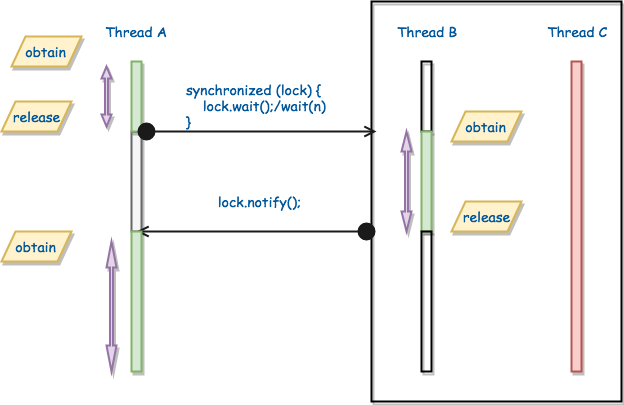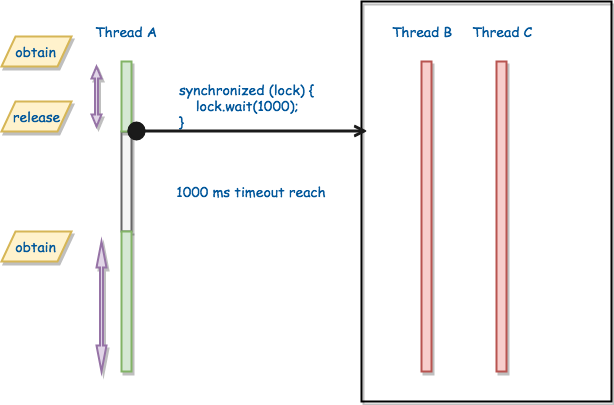sleep & wait
2018-03-7 小文字
前言
编码的时候经常会遇到sleep,比如模拟耗时,我们会写一个Thead.sleep(5*1000);
在线程同步的时候也经常用wait/notify; 很明显我们在不同场景使用了不同方法,并且习以为常了。
那么sleep和wait的区别到底是什么?
sleep是怎么回事

首先sleep是Thread的静态方法,其次一定要try/catch, 因为sleep可能会抛异常,根据方法定义的说明文档,传入负数会抛出IllegalArgumentException,线程被中断会抛出InterruptedException
/**
* Causes the currently executing thread to sleep (temporarily cease
* execution) for the specified number of milliseconds, subject to
* the precision and accuracy of system timers and schedulers. The thread
* does not lose ownership of any monitors.
*
* @param millis
* the length of time to sleep in milliseconds
*
* @throws IllegalArgumentException
* if the value of {@code millis} is negative
*
* @throws InterruptedException
* if any thread has interrupted the current thread. The
* <i>interrupted status</i> of the current thread is
* cleared when this exception is thrown.
*/
public static native void sleep(long millis) throws InterruptedException;
根据上述说明,我们可以得出两点结论:
- sleep对当前线程生效;
- 仅仅让出了CPU资源,这个动作和同步,锁之间没有任何影响,该持有的仍旧持有,锁的状态不变;
- 睡眠时间到后,继续执行后续代码逻辑;
wait是怎么回事


wait本身是Object的一个成员方法,因此可以在任意对象上调用;
/**
* Causes the current thread to wait until another thread invokes the
* {@link java.lang.Object#notify()} method or the
* {@link java.lang.Object#notifyAll()} method for this object.
* In other words, this method behaves exactly as if it simply
* performs the call {@code wait(0)}.
* <p>
* The current thread must own this object's monitor. The thread
* releases ownership of this monitor and waits until another thread
* notifies threads waiting on this object's monitor to wake up
* either through a call to the {@code notify} method or the
* {@code notifyAll} method. The thread then waits until it can
* re-obtain ownership of the monitor and resumes execution.
* <p>
* As in the one argument version, interrupts and spurious wakeups are
* possible, and this method should always be used in a loop:
* <pre>
* synchronized (obj) {
* while (<condition does not hold>)
* obj.wait();
* ... // Perform action appropriate to condition
* }
* </pre>
* This method should only be called by a thread that is the owner
* of this object's monitor. See the {@code notify} method for a
* description of the ways in which a thread can become the owner of
* a monitor.
*
* @exception IllegalMonitorStateException if the current thread is not
* the owner of the object's monitor.
* @exception InterruptedException if any thread interrupted the
* current thread before or while the current thread
* was waiting for a notification. The <i>interrupted
* status</i> of the current thread is cleared when
* this exception is thrown.
* @see java.lang.Object#notify()
* @see java.lang.Object#notifyAll()
*/
public final void wait() throws InterruptedException {
wait(0);
}
wait的注释就比较长了,基本描述了一个实例如何使用wait,如何唤醒 使用wait必须包裹在同步代码块之内,并且同步块持有对象的锁,然后根据业务逻辑执行wait等待;
Object lock = new Object();
synchronized (lock) {
try {
// TODO business logic
lock.wait(1000);
} catch (InterruptedException e1) {
e1.printStackTrace();
}
}
System.out.println("After wait 1000ms");
wait支持参数传入,表示超时时间,在上述代码中,1000ms之后即使没有其他线程调用notify/notifyAll,这里也会往后执行,输出After wait 1000ms;如果希望永久等待,可以不传时间,或者传入0,这样将不会看到最后一个日志输出。
从示例代码可以知道,首先synchronized获取了lock对象锁,接着通过lock.wait方法,释放了CPU资源,也释放了lock锁,这就意味着,其他线程如果尝试获取lock锁是可以成功的。
如果lock锁呗其他线程占用,那么即使超时时间到达了,也不会继续往下执行;
下面的例子可以验证这个结论:
new Thread(new Runnable() {
@Override public void run() {
System.out.println("[1]execute");
synchronized (lock) {
try {
new Thread(new Runnable() {
@Override public void run() {
System.out.println("[2]New Thread executed " + Thread.currentThread());
synchronized (lock) {
System.out.println("[2]lock obtained by " + Thread.currentThread());
try {
Thread.sleep(5000);
System.out.println("[2]Job done,release lock " + Thread.currentThread());
lock.notify();
} catch (InterruptedException e1) {
e1.printStackTrace();
}
}
}
}).start();
System.out.println("[1]Sleep 1000ms");
Thread.sleep(1000);
System.out.println("[1]lock wait 1000");
lock.wait(1000);
} catch (InterruptedException e1) {
e1.printStackTrace();
}
}
System.out.println("[1]After wait 1000ms");
}
}).start();
输出日志:
[1]execute
[1]Sleep 1000ms
[2]New Thread executed Thread[Thread-1,5,main]
[1]lock wait 1000
[2]lock obtained by Thread[Thread-1,5,main]
[2]Job done,release lock Thread[Thread-1,5,main]
[1]After wait 1000ms
小结
wait与sleep都可以休眠一定时间后恢复,但是sleep在休眠期间任然持有原来已经获得状态,锁持有不变,仅仅让出CPU资源供其他线程使用;二wait这是直接释放了持有锁,因此其他请求相同锁的线程会获取成功,并且如果锁被持有的后,只有等待再次释放,原线程才能继续得到执行;